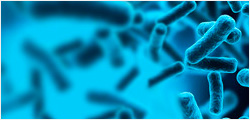Angiostatin K1-3, Human
Angiostatin K1-3 is a ~30 kDa fragment of plasminogen that has been shown to act as a potent inhibitor of angiogenesis and tumor growth in vitro and in vivo. K1-3 form the “triangular bowl-like structure” of angiostatin. This structure is stabilized by interactions between inter-kringle peptides and kringles, although the kringle domains do not directly interact with each other. Angiostatin is effectively divided into two sides. The active site of K1 is found on one side, while the active sites of K2 and K3 are found on the other. This is hypothesized to result in the two different functions of angiostatin. The K1 side is believed to be primarily responsible for the inhibition of cellular proliferation, while the K2-K3 sides is believed to be primarily responsible for the inhibition of cell migration.
| Z02730 | |
|
|
|
| ¥13,804.00 | |
|
|
|
|
|
|
| Ask us a question | |








































